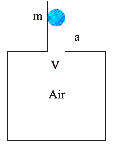Amplitude of an SHO is A. When it is at a distance y from the mean position of the path of its oscillation, the SHO receives blow in the direction of its motion, which doubles its velocity instantaneously. Find the new amplitude of its oscillations.Solution in Gujrati
Velocity of SHO at displacement y.
Now instantaneous velocity after giving blow in the direction of motion is ,
where is new amplitude
.
Topper's Solved these Questions
- OSCILLATIONSBOOK - KUMAR PRAKASHANCHAPTER - OSCILLATIONSEXERCISE - SECTION-C (OBJECTIVE QUESTIONS)
60 Videos
- OSCILLATIONSBOOK - KUMAR PRAKASHANCHAPTER - OSCILLATIONSEXERCISE - SECTION-C (OBJECTIVE QUESTIONS TRUE OR FALSE)
8 Videos
- OSCILLATIONSBOOK - KUMAR PRAKASHANCHAPTER - OSCILLATIONSEXERCISE - SECTION-B (ADDITIONAL EXERCISE)
9 Videos
- OBJECTIVE QUESTIONS AS PER NEW PAPER STYLE BOOK - KUMAR PRAKASHANCHAPTER - OBJECTIVE QUESTIONS AS PER NEW PAPER STYLE EXERCISE - CHAPTER - 8 (Match Type questions)
5 Videos
- PHYSICAL WORLDBOOK - KUMAR PRAKASHANCHAPTER - PHYSICAL WORLDEXERCISE - SECTION-E (QUESTIONS FROM MODULE)
9 Videos
Similar Questions
What is the phase difference between the velocity and displacement of a paticle executing SHM?
View SolutionThe acceleration of SHO at mean position is maximum.
View SolutionAn air chamber of volume V has a neck area of cross section a into which a ball of mass m just fits and can move up and down without any friction (Fig.14.27). Show that when the ball is pressed down a little and released , it executes SHM. Obtain an expression for the time period of oscillations assuming pressure-volume variations of air to be isothermal [see Fig. 14.27].

View SolutionType of satellites are given in Column-I and their uses are given in Column-II. Match them properly :
Column-IColumn-II(1) Polar satellite(a) Tele communication(2) Geo-stationary satellite(b) Investigation(c) For information about atmosphere
View Solution.…. state of substance at very high temperature has generated hope of energy source for mankind.
View SolutionA particle is moving in a straight line with SHM of amplitude r . At a distance s from the mean position of motino, the particle receives a blow in the direction of motion which instataneously triple the velocity. Find the new amplitude.
View SolutionA particle is moving in a straight line with S.H.M. of amplitude r. At a distance s from the mean position of motion, the particle receives a blow in the direction of motion which instantaneously doubles the velocity . Find the new amplitude.
View SolutionThe time period of oscillation of a SHO is π2s. Its acceleration at a phase angle π3rad from exterme position is 2ms−1. What is its velocity at a displacement equal to half of its amplitude form mean position? (in ms−1
View SolutionA particle performs simple harmonic motion wit amplitude A. its speed is double at the instant when it is at distance A3 from equilibrium position. The new amplitude of the motion is
View SolutionVelocity of a simple harmonic oscillator in the mean position is v0. If its amplitude is doubled, without changing its period of oscillation, its velocity in the mean position will be
View SolutionA particle executes SHM on a straight line path. The amplitude of oscillation is 3 cm. Magnitude of its acceleration is eqal to that of its velocity when its displacement from the mean position is 1 cm. Find the time period of S.H.M.
View SolutionWhen an oscillator completes 100 oscillations its amplitude reduces to (1)/(3) of its initial value. What will be its amplitude, when it completes 200 oscillations ?
View SolutionSHO of periodic time 2 second starts its oscillation from the lower end of its path of motion, its phase will be……….at time 2 second.
View SolutionWhen an oscillator completed 100 oscillations its amplitude reduced to 1/3 of initial value. What will be its amplitude, when it completes 200 oscilations ?
View SolutionA particle is executing simple harmonic motion with an amplitude of 2m . The difference in the magnitudes of its maximum acceleration and maximum velocity is 4. The time period of its oscilation and its velocity when it is 1m away from the mean position are respectively.
View Solution
